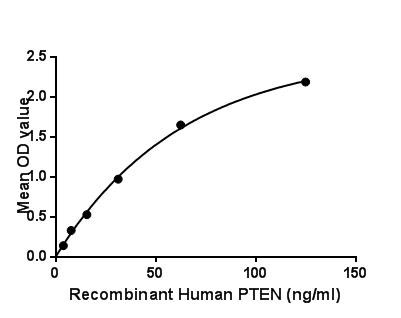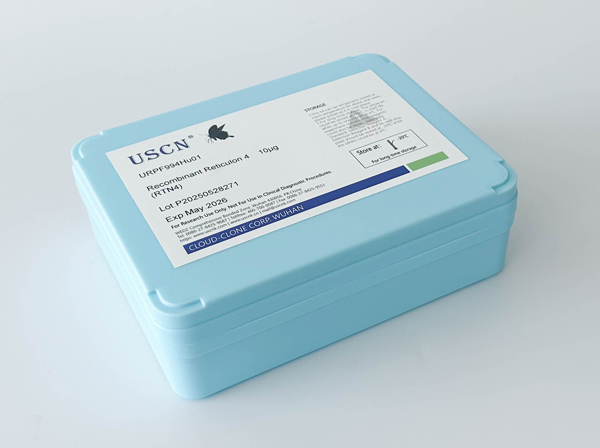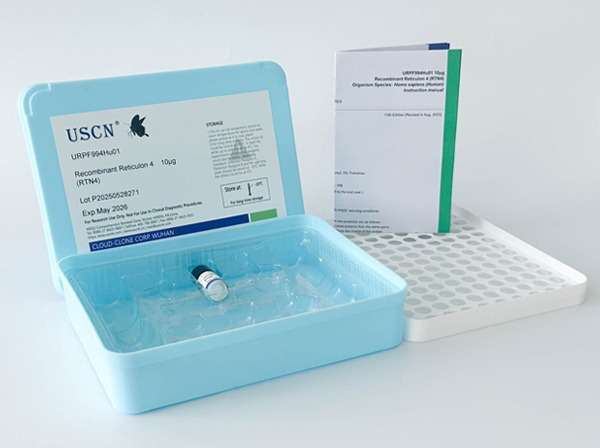Active Phosphatase And Tensin Homolog (PTEN)
BZS; MHAM; MMAC1; PTEN1; TEP1; Mutated In Multiple Advanced Cancers 1; Phosphatidylinositol 3,4,5-trisphosphate 3-phosphatase and dual-specificity protein phosphatase PTEN
- Product No.UAPF822Hu01
- Organism SpeciesHomo sapiens (Human) Same name, Different species.
- Buffer FormulationPBS, pH7.4, containing 0.01% SKL, 5% Trehalose.
- TraitsFreeze-dried powder
- Purity> 90%
- Isoelectric Point5.9
- ApplicationsCell culture; Activity Assays.
- Download Instruction Manual
- UOM 10µg50µg 200µg 1mg 5mg
-
FOB
US$ 132
For more details, please contact local distributors!US$ 330
For more details, please contact local distributors! US$ 660
For more details, please contact local distributors! US$ 1980
For more details, please contact local distributors! US$ 4950
For more details, please contact local distributors!
ACTIVITY TEST of the Active Phosphatase And Tensin Homolog (PTEN)

Figure. The binding activity of PTEN with TP53.
Phosphatase and tensin homolog (PTEN) is a protein is widely expressed throughout the body. PTEN protein acts as a phosphatase to dephosphorylate phosphatidylinositol (3,4,5)-trisphosphate (PtdIns (3,4,5)P3 or PIP3). PTEN specifically catalyses the dephosphorylation of the 3’ phosphate of the inositol ring in PIP3, resulting in the biphosphate product PIP2 (PtdIns (4,5) P2). PTEN also has weak protein phosphatase activity, but this activity is also crucial for its role as a tumor suppressor. PTEN's protein phosphatase activity may be involved in the regulation of the cell cycle, preventing cells from growing and dividing too rapidly. Besides, Tumor Protein p53 (TP53) has been identified as an interactor of PTEN, thus a binding ELISA assay was conducted to detect the interaction of recombinant human PTEN and recombinant human TP53. Briefly, PTEN were diluted serially in PBS, with 0.01% BSA (pH 7.4). Duplicate samples of 100μL were then transferred to TP53-coated microtiter wells and incubated for 2h at 37℃. Wells were washed with PBST and incubated for 1h with anti-PTEN pAb, then aspirated and washed 3 times. After incubation with HRP labelled secondary antibody, wells were aspirated and washed 3 times. With the addition of substrate solution, wells were incubated 15-25 minutes at 37℃. Finally, add 50µL stop solution to the wells and read at 450nm immediately. The binding activity of PTEN and TP53 was shown in Figure 1, and this effect was in a dose dependent manner.
USAGE of the Active Phosphatase And Tensin Homolog (PTEN)
Reconstitute in 10mM PBS (pH7.4) to a concentration of 0.1-1.0 mg/mL. Do not vortex.
STORAGE of the Active Phosphatase And Tensin Homolog (PTEN)
Avoid repeated freeze/thaw cycles. Store at 2-8°C for one month. Aliquot and store at -80°C for 12 months.
STABILITY of the Active Phosphatase And Tensin Homolog (PTEN)
The thermal stability is described by the loss rate. The loss rate was determined by accelerated thermal degradation test, that is, incubate the protein at 37°C for 48h, and no obvious degradation and precipitation were observed. The loss rate is less than 5% within the expiration date under appropriate storage condition.
INCREMENT SERVICES
BCA Protein Quantification Kit
Molecular Mass Marker for Protein
Monoclonal Antibody Customized Service
Polyclonal Antibody Customized Service
Protein Activity Test Experiment Service
Electrophoretic Mobility Shift Assay (EMSA) Experiment Service
Buffer
Lentivirus Packaging Experiment Service
Adenovirus Packaging Experiment Service
Real Time PCR Experimental Service
Spike RBD Protein (S-RBD)
Protein G
Protein A



